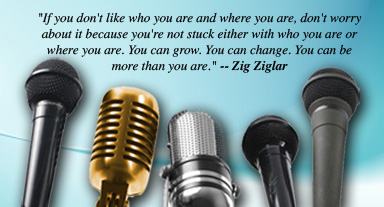So you’ve booked a speaker and signed the contract. Now it’s time for event logistics.
Chances are you’ve already established the location of your event, meeting or conference – but have you put any thought into the setup of the specific room your speaker will be presenting in?
It’s astounding how something as basic as the setup of a room can really affect the success of a presentation. A room’s layout and seating arrangements can determine how interaction will occur: whether it will be one-directional – from the presenter to the audience – or whether it will be multi-directional and interactive, fostering collaborative communication. Other aspects to consider are the audience’s comfort and the ease of accessibility. It is extremely important that you determine the most effective and most appropriate setup for your speaker’s presentation.
The type of event and the size of your audience are two of the main factors to consider. For instance, a keynote presentation for a conference with 1,000 attendees will of course require a different room size and layout than a half-day workshop with only 15 participants.
Here are four of the most common room setups you may want to consider.
Setup No. 1: Theatre Style
The theatre-style setup is most suitable for a speaking event that has a large audience. Think of the theatre-style setup as, well, a theatre. The front of the room features a large stage or platform, and the seating radiates back from the stage in two or three sections of rowed seats. In some cases, the floor of the seating area is slanted so that the rows are more elevated the farther they are from the stage, making it easier for the audience to see.
If you’re holding a large conference or professional speaking event, it’s quite likely your event is being held in an actual theatre, recital hall or conference hall. The nice thing about venues like these is that the setup work is already done for you. However, if you plan on booking an actual theatre or recital hall as your venue, be sure you will have the audience to fill it. These venues are costly and if there are only 100 people in a space that fits 1,000, the event may feel underwhelming and under-attended – even if it is not.
It is also possible to turn a medium- or large-sized room in a conference centre or hotel into your own theatre-style venue by arranging a platform stage and setting up your seating in sectioned rows. Be sure to arrange your chairs so that audience members will have some breathing room, and to make the aisles wide enough so they are easily accessible.
A theatre-style setup best benefits a speaker whose presentation is really a monologue, such as a lecturer or keynote speaker. Having your speaker on stage, illuminated by lights and speaking to a silent and rapt audience, creates the feeling that he is truly a professional who is there to entertain, educate and impart his knowledge. The theatre-style setup lends a feeling of professionalism and formality to your event.
The main drawback of a theatre-style setup is that audience participation is limited. As a result, this setup is not recommended if your intention is to foster discussion and interaction within the audience. The theatre-style setup also makes it difficult for the audience to take notes. So if your speaker’s presentation requires rigorous note taking, you are better off using the classroom-style setup, which is discussed below.
Setup No. 2: Banquet Style
A banquet-style setup is another large group setup that is most often employed when you’re hosting a banquet or a dinner reception. If your speaker is presenting at an event that involves a sit-down dinner, this setup is really the best option. It involves round tables, spread throughout the room, with six to 10 people seated per table. Think about any wedding you’ve attended at a hotel or conference centre – chances are, the reception was laid out in banquet style. The main benefit of banquet-style seating is that it allows you to serve a meal during your speaking event.
But there is also a drawback to banquet-style seating. Because banquet tables tend to be round, usually about half of the people at any given table will have to turn around in their seats if they want to face the speaker. This can be awkward and uncomfortable – especially when you’re trying to eat. However, if you time the event’s proceedings just right – for instance by having some other sort of entertainment, such as music or a DJ, during the main part of the meal – you should be able to arrange things so the speaker’s presentation is not overlapping with the meal.
Setup No. 3: Classroom Style
The classroom-style setup is similar to the theatre-style setup in that they both involve the speaker being at the front of the room, with the audience in rows facing the stage or speaker. The difference though is that the classroom-style setup has the audience sitting at tables.
The main benefits here are that the audience can easily take notes on the presentation and there is room to hand out and make use of reference materials. Another benefit is that the tables allow the audience or participants to enjoy beverages and other refreshments without having to hold them in their hands or on their laps.
This setup can be appropriate for groups of many different sizes, from large groups of a couple of hundred people (think of a lecture hall in a university or college setting) to smaller groups of 30 people or less (think of a high school classroom). The setup encourages a classroom sensibility of learning where audience members will likely feel more comfortable participating and asking questions. As a result, a classroom-style setup is appropriate for lectures or keynote speeches, but is also suitable for more hands-on presentations, such as workshops and training sessions.
Setup No. 4: Boardroom and U-Shape Style
The boardroom-style setup is best for a small group of people. And it is best suited for intimate presentations such as meetings, workshops and training sessions. Most conference centres, event halls and corporate offices have boardrooms available for use, however it’s easy to create your own boardroom in any given space. Boardrooms generally have one long table in the centre of the room, with chairs laid out all around it.
A drawback to a boardroom-style setup is that the boardroom table can sometimes be too long, and people may have trouble seeing, hearing or communicating with the people at the other end of the table. As a result, meeting or workshop participants may feel compelled to interact only with the people at the end of the table that they’re situated.
The U-Shape setup is a variation of the boardroom-style setup. Instead of one long table, arrange three tables in the shape of the letter “U,” and set up chairs around the outer edges of the tables. This way, everyone in attendance will be able to see each other, making it easier to participate, communicate and hold discussions.
In both of these configurations, the speaker will likely want to stand at one end of the room to give their presentation. In the case of the boardroom-style setup, the speaker may want to take one of the short ends of the table for himself, to lay out and organize his presentation materials. In the case of the U-Shape setup, the speaker may want to have her own small table at the top of the “U” for organizational purposes, and she may want to make use of the space in the middle of the “U” to move about during her talk.
If you’re unsure which configuration is most appropriate for your event and for your speaker’s presentation, don’t feel as though you have to make the decision yourself. Professional speakers have plenty of experience presenting in rooms of all shapes, sizes and setups. So be sure to ask your speaker for his or her preference and suggestions.
Stay tuned tomorrow for more tips on preparing your venue. Till next time!


